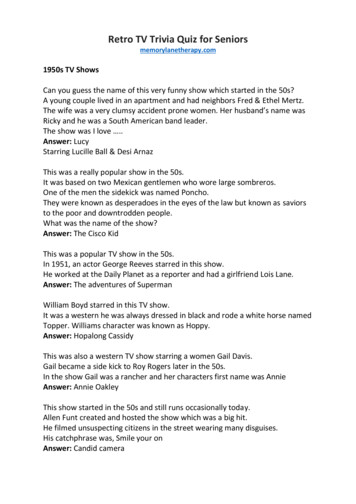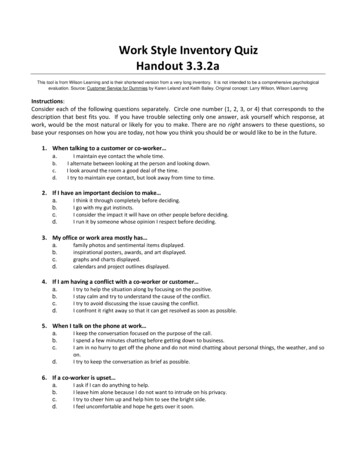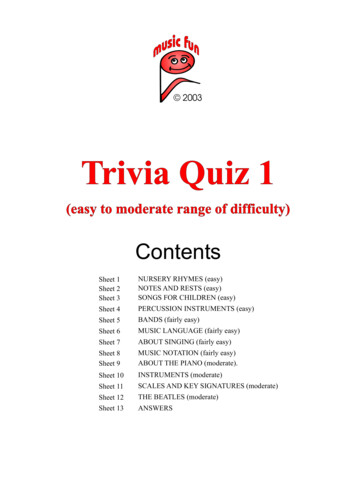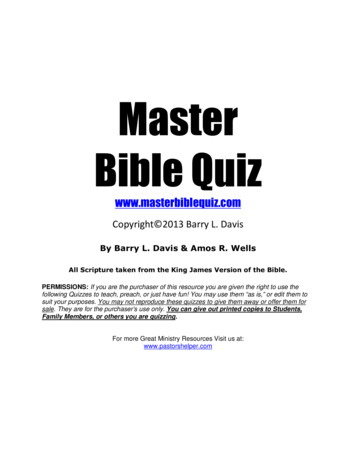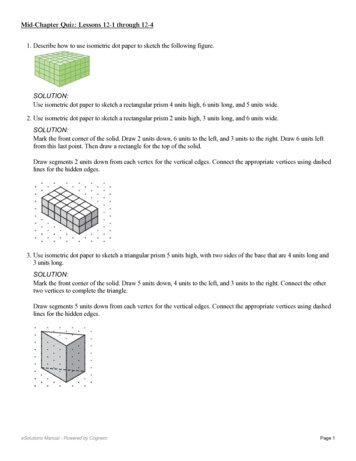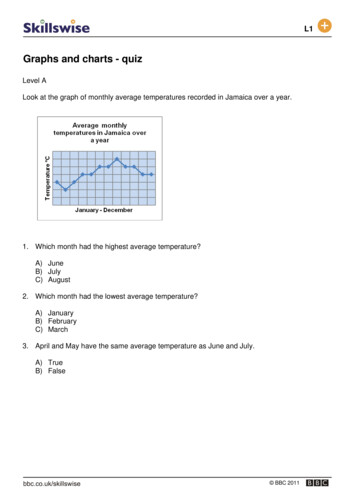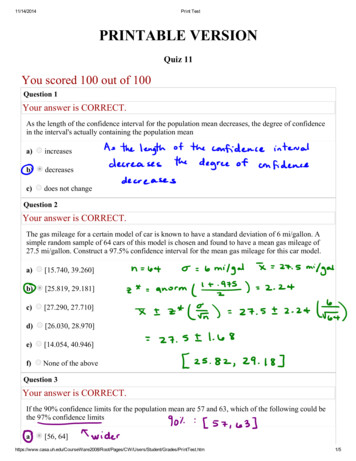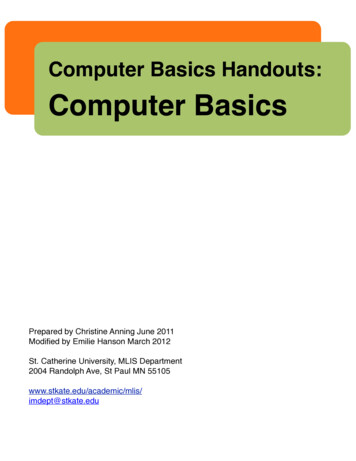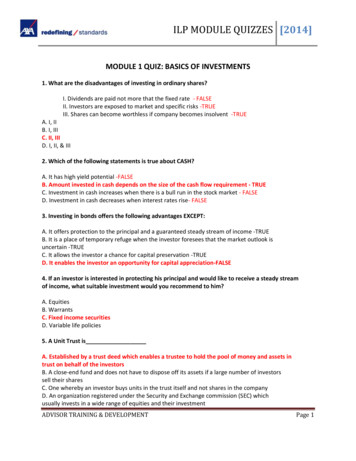
Transcription
ILP MODULE QUIZZES [2014]MODULE 1 QUIZ: BASICS OF INVESTMENTS1. What are the disadvantages of investing in ordinary shares?I. Dividends are paid not more that the fixed rate - FALSEII. Investors are exposed to market and specific risks -TRUEIII. Shares can become worthless if company becomes insolvent -TRUEA. I, IIB. I, IIIC. II, IIID. I, II, & III2. Which of the following statements is true about CASH?A. It has high yield potential -FALSEB. Amount invested in cash depends on the size of the cash flow requirement - TRUEC. Investment in cash increases when there is a bull run in the stock market - FALSED. Investment in cash decreases when interest rates rise- FALSE3. Investing in bonds offers the following advantages EXCEPT:A. It offers protection to the principal and a guaranteed steady stream of income -TRUEB. It is a place of temporary refuge when the investor foresees that the market outlook isuncertain -TRUEC. It allows the investor a chance for capital preservation -TRUED. It enables the investor an opportunity for capital appreciation-FALSE4. If an investor is interested in protecting his principal and would like to receive a steady streamof income, what suitable investment would you recommend to him?A. EquitiesB. WarrantsC. Fixed income securitiesD. Variable life policies5. A Unit Trust isA. Established by a trust deed which enables a trustee to hold the pool of money and assets intrust on behalf of the investorsB. A close-end fund and does not have to dispose off its assets if a large number of investorssell their sharesC. One whereby an investor buys units in the trust itself and not shares in the companyD. An organization registered under the Security and Exchange commission (SEC) whichusually invests in a wide range of equities and their investmentADVISOR TRAINING & DEVELOPMENTPage 1
ILP MODULE QUIZZES [2014]6. What are the advantages of investing in preferred shares?I. It gives shareholders the right to a fixed dividend - TRUEII. Has priority over company assets during dissolution -TRUEIII. They enjoy benefit of capital appreciation -TRUEA. I, II and IIIB. I & IIC. I and IIID. II and III7. The duties of the trustee of unit investment trust do not include:A. Managing the portfolio of investment and administering the buying and selling of shares inthe unit trust itselfB. Ensuring that the fund manager adhere to the provision of the trust deedsC. Acting generally to protect the unit holdersD. Holding the pool of money and assets in trust in behalf of the investors8. Which of the following statements is TRUE?A. Amount invested in cash depends on the size of cash flow requirement -TRUEB. Investment in cash decreases when interest rates rise -FALSEC. Investment in cash increases hen there is a strong performance in the stock market -FALSED. Cash has high yield potential -FALSE9. The three basic types of corporate stocks includeA. Futures, investment trusts and optionsB. Fixed income stocks, treasury bills and time depositsC. Debenture stocks, loan stocks and convertible stocksD. Preferred stocks, unit trusts and derivatives10. Which of the following investment options entitles the holder to ownership and a share in theprofits in the form of dividends?A. CashB. BondsC. FuturesD. Ordinary sharesADVISOR TRAINING & DEVELOPMENTPage 2
ILP MODULE QUIZZES [2014]MODULE 2 QUIZ: KEY CONSIDERATIONS IN INVESTING1. Diversification in investment involves A. Putting all the funds under management into one category of investment - FALSEB. Spreading the risks of investment by not putting the fund into several categories ofinvestment. -FALSEC. Reducing the risks of investment by putting the fund under management into severalcategories of investmentD. Reducing the risks of investment by putting all one’s egg in one basket-FALSE2. Which of the following statements about diversification in portfolio management is FALSE?A. A diversified portfolio provides greater security to an investor without sacrificing the returnsof the portfolio. -TRUEB. Diversification can completely eliminate risk of investing in stocks in a portfolio. -FALSEC. Diversification can involve purchasing different types of stocks and investing in stocks ofdifferent countries. -TRUED. Diversification helps to spread the portfolio risk by investing in different categories ofinvestment in a portfolio.-TRUE3. Risk can be classified into two particular categories in relation to investment. TheyincludeI. The risk of not losing some or all of a person’s initial investment -FALSEII. The risk of rate of return on the investment not matching up to the individual’s expectation -TRUEIII. The risk of rate of return on the investment matching up to the individual’s expectation -FALSEIV. The risk of losing some or all of a person’s initial investment- TRUEA. I and IIIB. I and IIC. III and IVD. II and IV4. Which of the following statements about investment objectives is FALSE?A. People invest money in fixed deposits to produce high and guaranteed returns -FALSEB. People invest money to enhance a comfortable standard of living -TRUEC. People invest their money to provide funds for higher education of children -TRUED. Investment in commodities has no regular income but offer the possibility of capital gains-TRUEADVISOR TRAINING & DEVELOPMENTPage 3
ILP MODULE QUIZZES [2014]MODULE 3 QUIZ: TRADITIONAL VS VARIABLE1. Which of the following statements about characteristics of variable life policies are TRUE?I. Variable life policies generally have a larger exposure to equity investment than withparticipating and other traditional policies. -TRUEII. The protection costs are generally met by implicit charges, which vary with age and level ofcover. -FALSEIII. Commissions and company expenses are met by a variety of explicit charges, some ofwhich are variable. -TRUEA. I, II and IIIB. I and IIC. II and IIID. I and III2. The following are fundamental differences between traditional participating life insurancepolicies and variable life insurance policies:I. Variable life insurance policies are less likely to offer more choice in terms of the type ofinvestment funds. -FALSEII. The investment element of variable life insurance policies is made known to thepolicyowner at the onset and is invested in a separately identifiable fund which is made upof units of investment. -TRUEIII. Variable life insurance policies offer the potential for higher returns. -TRUEIV. Traditional participating policies aim to produce a steady return by smoothing out marketfluctuations. -TRUEA. I, II and IVB. II, III and IVC. I, II and IIID. I, III and IV3. Which of the following statements about option to top-up under variable life insurance productsis FALSE?A. Policyowner may buy additional units in the variable life fund and these units will beallocated to new variable life insurance policies. -FALSEB. Further premiums at time of top-up will be used in full, after deducting charges for top-ups,to purchase additional units of the variable life funds. -TRUEC. To top-up a policy, the policyowner pays further single premium at the time of top-up. -TRUED. Policyowners are normally allowed to top-up their policies at any time, subject to aminimum amount. -TRUEADVISOR TRAINING & DEVELOPMENTPage 4
ILP MODULE QUIZZES [2014]4. Which of the following statements about variable life policies is/are TRUE?I. The withdrawal value is not guaranteed. -TRUEII. The volatility of the returns depends on the investment strategy of the fund. -TRUEIII. The variable life policy holder has direct control over investment decisions of the variablelife funds. -FALSEA. I, II and IIIB. II and IIIC. I and IIID. I and II5. With traditional life insurance products, the allocation to policyowners in the form of dividendsI. Is not directly linked to the life company’s investment performance -FALSEII. Has already been smoothened by the life company -TRUEIII. Does not have the highs and lows of investment returns as in good investment years of lifecompany -TRUEIV. Is not fixed at the inception of the policy, but are greatly dependent on the investmentperformance of the life company -TRUEA. I, II and IIIB. I, II and IVC. I, III and IVD. II, III and IV6. Which of the following statements about the investment returns under a variable life insurancepolicy is not TRUE?A. It is assured -FALSEB. It is not guaranteed -TRUEC. It fluctuates based on the rise and fall of market prices -TRUED. It is linked to the performance of the investment fund managed by the life company-TRUE7. Which of the following statements describe the differences between variable life insuranceproducts and traditional participating policies?I. Traditional participating life policies aim to produce steady return by smoothing out marketfluctuations, while variable life insurance policies offer the potential for higher returns butat the expense of market volatility and higher risk. -TRUEII. Variable life insurance products can take the form of whole life or endowment policies buttraditional participating life policies do not. -FALSEIII. The investment of variable life insurance policies is made known on the onset and isinvested in a separately identifiable fund, which is made up of units of investment. -TRUEADVISOR TRAINING & DEVELOPMENTPage 5
ILP MODULE QUIZZES [2014]A. I onlyB. I & III onlyC. II & III onlyD. I, II and III8. Which of the following is/are the main characteristic(s) of variable life policies?I. The policies can be used for investment, as a source of regular savings and protection. -TRUEII. The withdrawal values and protection benefits are determined by the investmentperformance of the underlying assets. -TRUEIII. The net cash values of the policies are the gross cash values shown in the policy thatincludes dividends up to the date of the surrender, less any indebtedness and interest. -FALSEA. IIB. IC. I, II and IIID. I and II9. Which of the following statements is FALSE?A. Variable life insurance policies offer investors with values indirectly linked to theinvestment performance of the life company. -FALSEB. The life company will carry out a valuation of its funds yearly and any surplus may beallocated to participating policy holder as cash dividends.C. Both whole life and endowment policies can be used as an investment media with benefitsthat become payable at a future date.D. The investment element of variable life policies varies according to underlying assets of theportfolio.10. Mr. Juan dela Cruz is currently earning P30,000 per month. He is 35 years old and has areasonable amount of savings. He has a moderate level of risk tolerance. What kind of policywould you recommend?A. Participating EndowmentB. Variable life policiesC. Participating Whole LifeD. AnnuitiesADVISOR TRAINING & DEVELOPMENTPage 6
ILP MODULE QUIZZES [2014]11. The following are characteristics of a variable life insurance policy:I. Its withdrawal value and protection benefits are determined by the investment performanceof the underlying assets. -TRUEII. Its protection costs are generally met by implicit charges. -FALSEIII. Its commissions and company expenses are met by a variety of explicit charges, notice ofwhich is given by life companies normally 6 months prior to any change in such charges. -TRUEIV. Its withdrawal value is normally the value of units allocated to the policyholder calculated atthe bid price -TRUEA. I, II and IIIB. II, III and IVC. I, II and IVD. I, III and IV12. Which of the following statements about the difference between variable life policies andendowment policies is/are FALSE?I. The policy values of variable life and endowment policies directly reflect the performance ofthe fund of the life company. -FALSEII. The premiums and benefits of the endowment policies are described at the inception of thepolicy whereas variable life policies are flexible as they are account driven. -TRUEIII. The benefits and risks of variable life and endowment policies directly accrue to thepolicyholders. -FALSEA. I and IIB. I, II and IIIC. I and IIID. II and III13. Which of the following is NOT a characteristic of a variable life policy?A. It is used solely for investment purposes. -FALSEB. The commission and office expenses are met by explicit charges. -TRUEC. It has generally, though not necessarily, more exposure to equity investments. -TRUED. Its account value is usually the value of units allocated to the policy calculated at theprevailing bid price.-TRUEADVISOR TRAINING & DEVELOPMENTPage 7
ILP MODULE QUIZZES [2014]14. The investment returns under variable life insurance policyI. Are not guaranteed -TRUEII. Are insured - FALSEIII. Are linked to the performance of the investment fund managed by the life office -TRUEIV. Fluctuate according to the rise and fall of market prices -TRUEA. I, II & IIIB. I, II, & IVC. I, III, & IVD. II, III, & IV15. The death benefit under regular premium variable life insurance policies is eitherI. The sum insured chosen by the life insured plus the value of units in the fund at the bidprice - TRUEII. The sum insured chosen by the life insured or the value of units in the fund at the bid price,whichever is higher. -TRUEIII. The minimum sum insured or the value of the units in the fund at the bid price, whichever ishigher -FALSEIV. The minimum sum insured plus the value of the units in the fund at the bid price -FALSEA. I & IIB. II & IIIC. III & IVD. I & IV16. Under variable life insurance policies,I. There is no guaranteed minimum sum assured for the purpose of declaring dividends -TRUEII. There is no guaranteed minimum sum assured as a level of life insurance protection -FALSEIII. Each of the policyowner’s premium will be used to purchase units, the number of which isdependent on the selling price of each unit -TRUEIV. Purchase of units can only be made from the variable life fund itself, which will then createnew units and the investment will add value to the fund -TRUEA. I, II and IIIB. I, II and IVC. I, III and IVD. II, III and IVADVISOR TRAINING & DEVELOPMENTPage 8
ILP MODULE QUIZZES [2014]MODULE 4 QUIZ: HOW VARIABLE LIFE INSURANCE WORKS1. The offer/selling price under a variable life insurance policy is:A. The price at which units under the policy are bought back by the life company -FALSEB. The price at which units under the policy are offered for sale by the life company -TRUEC. Also known as bid price -FALSED. A fixed amount throughout the life of the policy -FALSE2. Under the dual pricing method of single premium policies,A. The policyholder buys the units at the company buying price and sells the units at thecompany selling price -FALSEB. The policyholder buys the units at the offer price and sells the units at the bid price -TRUEC. There is only one price quoted whether the policyholder is buying or selling his units -FALSED. The bid price is always higher than the offer price -FALSE3. Variable life insurance policyholders may make withdrawals in terms ofA. Number of units through cancellation of units -TRUEB. Fixed monetary amount only through reduction of the life cover/sum insured -FALSEC. Number of units or fixed monetary amount through reduction of life cover/sum insured -FALSED. Number of units or fixed monetary amount through reduction/cancellation of units -TRUE (BESTANSWER)4. If the current offer price P 2.50 and the bid-offer-spread 4%, calculate for the bid price:A. P 2.4B. P 2.5C. P 2.6D. P 2.75. A single premium variable life is issued to a person with the following details:Single Premium P 100,000Initial Charge 5% of the single premiumMortality Charge 1.6% of the single premiumOffer Price: P 2.50Bid-offer-spread: 4%Assumptions:Compute for the number of units allocated to the policy when it was issued, assuming that allcharges are deducted by canceling units after the whole single premium is used to buy units.ADVISOR TRAINING & DEVELOPMENTPage 9
ILP MODULE QUIZZES [2014]A. 36, 520 unitsB. 38, 450 unitsC. 37, 250 unitsD. 39, 320 units6. Using the details in Question 5, compute for the number of units allocated to the policy whenit was issued. Assuming that the charges are deducted in the following manner:I. The initial charge is deducted from the single premiumII. The remaining amount is used to buy unitsIII. The mortality charge is cancelled from units broughtA. 38,453.3233 unitsB. 37,250.3333 unitsC. 39,232.3233 unitsD. 37,333.3333 units7. Over the next 10 years, the bid price is projected to constantly increase by 5% annually.Compute for the offer price after 10 years if the bid price now is P 3.50 and the bid-offer spreadis 5%.A. 5.70B. 4.10C. 6.00D. 3.458. Using the details and assumptions on question 5, calculate the yield to the policyholder if after15 years, the offer price increased to 4.35.A. 2.99% or yield (1.556) 1/15 –1B. 7.03% or yield (2.768) 1/15 –1C. 2.52% or yield (1.456) 1/15 –1D. 2.01% or yield (1.348) 1/15 –19. The protection costs under a variable life insurance policyI. Are met by a flat initial charges for regular premium plans -FALSEII. Are generally covered by cancellation of units in the fund -TRUEIII. Are generally met by explicit charges stipulated openly in policy terms - TRUEIV. Vary with age of policyowner and level of cover -TRUEA. I, II and IIIB. I, II and IVC. I, III and IVADVISOR TRAINING & DEVELOPMENTPage 10
ILP MODULE QUIZZES [2014]D. II, III and IV10. Which of the following statements is/are FALSE?I. The bid-offer spread is used to provide death benefit for the variable life insurance policy. FALSEII. The bid-price is always higher than offer price. -FALSEIII. The bid-offer spread is usually about 5%. -TRUEIV. There are two types of death benefit under the variable life insurance product. They mayoffer either or both types depending on its product design and discretion of the policyholder. TRUEA. I & II onlyB. II & III onlyC. II & IV onlyD. none of the above11. The policy fee payable under a variable life insurance policy is to cover:A. The handling charges by professional investment managers - FALSEB. The price for each unit bought under the variable like insurance policy - FALSEC. The mortality costs of the variable life insurance policy -FALSED. The administrative expenses of setting up the variable life insurance policy12. This is called the difference between the offer price and bid price:A. Bid price spreadB. Offer price spreadC. Bid offer spreadD. None of the above13. If the current offer price P 1.50 and the bid-offer-spread 5%, calculate for the bid price:A. P 1.367B. P 1.428C. P 1.408D. P 1.23414. Mr. Roman wishes to invest P 20,000 in a single premium variable life policy with the followingparameters:Offer price P 1.20Bid-offer-spread 5%Policy Fee P 120.00Administrative and Mortality Charge 2.5% of single premiumADVISOR TRAINING & DEVELOPMENTPage 11
ILP MODULE QUIZZES [2014]Assumptions:The charges and fees are deducted by canceling units from the policy at inception.How many units can Mr. Roman purchase?A. 16, 150.76B. 16,666.67C. 16,122.81D. none of the above15. Mr. Roman wishes to invest P 25,000 in a single premium variable life insurance policy with thefollowing parameters:Bid price P 1.33Bid-offer-spread 5%Policy Fee P 100Administrative and Mortality Charge 2.0% of single premiumAssumptions:The charges and fees are deducted by canceling units from the policy at inception.A. 17,857.14B. 17,406.01C. 17,428.57D. 18,245.8616. Using the details in question 14, calculate the yield of the policyholder if after 10 years, the bidprice increased to Php 2.62.A. (1.82) 1/10 –1B. (1.65) 1/5 –1C. (1.80) 1/10 –1D. none of the above17. Mr. Smith bought a single premium variable life policy and obtained 10,000 units in hisaccount with the following parameters:Offer Price P 1.10Bid-offer-spread 5%All applicable charges are already deducted from the single premiumAssumption:After 10 years, the offer price has consistently increased by 6% annually. If the policy was fullywithdrawn 10 years after, how much will the full withd
ILP MODULE QUIZZES [2014] ADVISOR TRAINING & DEVELOPMENT Page 3 MODULE 2 QUIZ: KEY CONSIDERATIONS IN INVESTING 1. Diversification in investment involves A. Putting all the funds under management into one category of investment - FALSE B. Spreading the risks of investment by not putti
